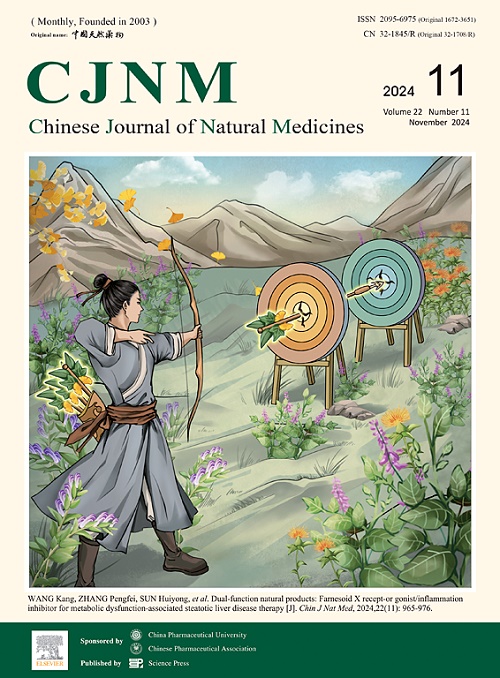Shionone通过减轻小胶质细胞介导的神经炎症来保护脑缺血损伤
IF 4.9
2区 医学
Q1 INTEGRATIVE & COMPLEMENTARY MEDICINE
引用次数: 0
摘要
小胶质细胞是中枢神经系统(CNS)的常驻免疫细胞,在缺血性脑损伤的急性期迅速从静止状态过渡到活跃状态。这种活跃状态介导了可加重损伤的促炎反应。在此急性期靶向半暗带小胶质细胞的促炎反应可有效减轻脑损伤。Shionone (SH)是一种从紫菀属(Asteraceae)的干根和根茎中提取的活性成分,被报道在脓毒症诱导的急性肺损伤中调节巨噬细胞的炎症反应。然而,其在脑卒中后神经炎症中的功能,特别是小胶质细胞介导的神经炎症,仍未被研究。本研究发现,SH显著抑制脂多糖(LPS)诱导的炎性细胞因子,包括白细胞介素-1β (IL-1β)、肿瘤坏死因子-α (TNF-α)和诱导型一氧化氮合酶(iNOS)在体外小胶质细胞中的升高。此外,结果表明,SH减轻了大脑中动脉闭塞(MCAO)小鼠的梗死面积,改善了行为表现,这可能是由于SH治疗抑制了小胶质细胞炎症反应。机制上,SH能有效抑制丝氨酸-苏氨酸蛋白激酶B (AKT)、哺乳动物雷帕霉素靶蛋白(mTOR)和转录信号传导和激活因子3 (STAT3)的磷酸化。这些发现表明,SH可能是一种潜在的治疗剂,可以通过减轻小胶质细胞相关的神经炎症来缓解缺血性卒中(IS)。本文章由计算机程序翻译,如有差异,请以英文原文为准。
Shionone protects cerebral ischemic injury through alleviating microglia-mediated neuroinflammation
Microglia, the resident immune cells in the central nervous system (CNS), rapidly transition from a resting to an active state in the acute phase of ischemic brain injury. This active state mediates a pro-inflammatory response that can exacerbate the injury. Targeting the pro-inflammatory response of microglia in the semi-dark band during this acute phase may effectively reduce brain injury. Shionone (SH), an active ingredient extracted from the dried roots and rhizomes of the genus Aster (Asteraceae), has been reported to regulate the inflammatory response of macrophages in sepsis-induced acute lung injury. However, its function in post-stroke neuroinflammation, particularly microglia-mediated neuroinflammation, remains uninvestigated. This study found that SH significantly inhibited lipopolysaccharide (LPS)-induced elevation of inflammatory cytokines, including interleukin-1β (IL-1β), tumor necrosis factor-α (TNF-α), and inducible nitric oxide synthase (iNOS), in microglia in vitro. Furthermore, the results demonstrated that SH alleviated infarct volume and improved behavioral performance in middle cerebral artery occlusion (MCAO) mice, which may be attributed to the inhibition of the microglial inflammatory response induced by SH treatment. Mechanistically, SH potently inhibited the phosphorylation of serine-threonine protein kinase B (AKT), mammalian target of rapamycin (mTOR), and signal transducer and activator of transcription 3 (STAT3). These findings suggest that SH may be a potential therapeutic agent for relieving ischemic stroke (IS) by alleviating microglia-associated neuroinflammation.
求助全文
通过发布文献求助,成功后即可免费获取论文全文。
去求助
来源期刊

Chinese Journal of Natural Medicines
INTEGRATIVE & COMPLEMENTARY MEDICINE-PHARMACOLOGY & PHARMACY
CiteScore
7.50
自引率
4.30%
发文量
2235
期刊介绍:
The Chinese Journal of Natural Medicines (CJNM), founded and sponsored in May 2003 by China Pharmaceutical University and the Chinese Pharmaceutical Association, is devoted to communication among pharmaceutical and medical scientists interested in the advancement of Traditional Chinese Medicines (TCM). CJNM publishes articles relating to a broad spectrum of bioactive natural products, leading compounds and medicines derived from Traditional Chinese Medicines (TCM).
Topics covered by the journal are: Resources of Traditional Chinese Medicines; Interaction and complexity of prescription; Natural Products Chemistry (including structure modification, semi-and total synthesis, bio-transformation); Pharmacology of natural products and prescription (including pharmacokinetics and toxicology); Pharmaceutics and Analytical Methods of natural products.
 求助内容:
求助内容: 应助结果提醒方式:
应助结果提醒方式:


